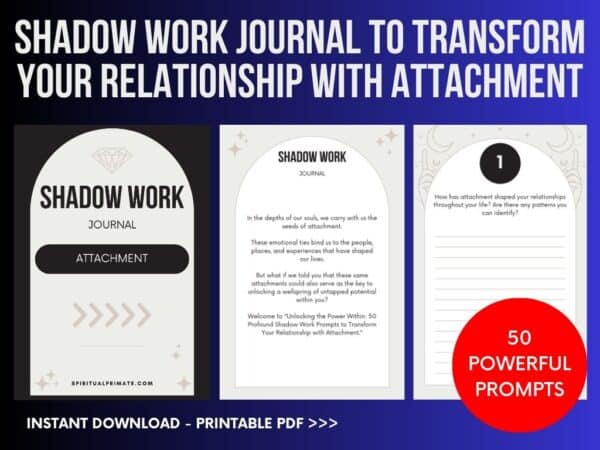In the depths of our souls, we carry with us the seeds of attachment. These emotional ties bind us to the people, places, and experiences that have shaped our lives. But what if we told you that these same attachments could also serve as the key to unlocking a wellspring of untapped potential within you?
Welcome to “Unlocking the Power Within: 50 Profound Shadow Work Prompts to Transform Your Relationship with Attachment.” This transformative journey will guide you through a labyrinth of self-reflection, helping you to shed light on the darkest corners of your psyche and ultimately, liberate yourself from the chains of attachment.
Are you ready to embark on a voyage of introspection that will change the way you perceive yourself and your relationships forever?

Understanding Attachment
Attachment is a term often used to describe the emotional bond that forms between people, or sometimes between a person and an object. This bond can be seen in various relationships, such as between parents and children, romantic partners, friends, and even pets. Attachments can be positive, providing us with a sense of security, comfort, and belonging. However, they can also become unhealthy if they lead to dependence or limit our personal growth.
In psychology, attachment theory is a popular concept that helps us understand how these emotional bonds are formed and maintained throughout our lives. The theory was first introduced by British psychologist John Bowlby in the 1950s and has since been expanded upon by numerous researchers. According to attachment theory, our early experiences with caregivers (usually our parents) shape the way we form and maintain attachments in our adult lives.
There are four primary attachment styles: secure, anxious, avoidant, and disorganized. A secure attachment style is considered healthy and leads to stable relationships, while the other three styles can cause challenges and insecurities in various aspects of life.
Secure attachment: Individuals with a secure attachment style feel comfortable relying on others and being relied upon in return. They are able to form deep emotional connections and trust in their relationships.
Anxious attachment: People with anxious attachment tend to worry about their relationships and often fear abandonment. They may become overly clingy or demanding in an attempt to maintain closeness.
Avoidant attachment: Those with avoidant attachment generally have difficulty forming close emotional bonds and may avoid intimacy altogether. They often prioritize independence and self-reliance.
Disorganized attachment: This attachment style is characterized by a mix of anxious and avoidant behaviors, leading to inconsistency and confusion in relationships.
Understanding attachment styles and how they influence our relationships can help us identify areas for growth and improvement. By recognizing our own attachment patterns, we can work towards developing healthier connections with others.
So, which attachment style do you identify with, and how might it be influencing your relationships?

Shadow Work: A Transformative Tool for Addressing Attachment Issues
Shadow work is a powerful self-help technique that involves exploring and integrating the hidden aspects of our psyche, including our unprocessed emotions, repressed memories, and unconscious beliefs. By engaging in shadow work, individuals can develop a deeper understanding of themselves and their relationships, ultimately transforming their relationship with attachment.
Attachment, as explained earlier, refers to the way we form emotional bonds with others. Our attachment styles are shaped by our early experiences with caregivers and can significantly influence our relationships throughout our lives. By addressing the underlying issues that contribute to our attachment styles, shadow work can help improve our connections with others and promote emotional healing.
The process of shadow work involves acknowledging and examining the parts of ourselves that we may have been avoiding or suppressing. This can include exploring our fears, insecurities, and unresolved traumas that may be contributing to our attachment patterns. By bringing these hidden aspects into conscious awareness and working through them, we can begin to heal and develop healthier attachment styles.
Here are some ways shadow work can help with attachment:
1. Identify and address unresolved trauma: Many attachment issues stem from early childhood experiences, such as neglect, abuse, or inconsistent caregiving. Shadow work can help us uncover and process these painful memories, allowing us to better understand how they have shaped our attachment styles and work towards healing.
2. Improve self-awareness: Through shadow work, individuals can gain a deeper understanding of their emotional needs, triggers, and patterns in relationships. This increased self-awareness can help individuals recognize when their attachment style is negatively impacting their relationships and take steps to change their behavior.
3. Develop empathy and understanding: By exploring our own shadow and understanding the origins of our attachment patterns, we can develop greater empathy and compassion for others. This can help us to better understand and support our partners, friends, and family members in their own attachment struggles.
4. Promote self-acceptance and self-love: A key aspect of shadow work is learning to accept and love all parts of ourselves, including our vulnerabilities and imperfections. By embracing our shadow, we can develop a stronger sense of self-worth and self-love, which can positively impact our attachment styles and relationships.
5. Enhance communication skills: As we become more aware of our own attachment patterns and emotional needs through shadow work, we can develop better communication skills to express our needs and boundaries in relationships. This can lead to more satisfying and secure attachments with others.
In conclusion, shadow work can be a transformative tool for addressing attachment issues and promoting healthier relationships. By exploring the hidden aspects of our psyche, we can develop a deeper understanding of our attachment patterns and take steps to heal and grow. As we engage in this powerful process of self-discovery and healing, we can transform our relationship with attachment and create more fulfilling connections with others.

Shadow Work Prompts for Attachment
1. How has attachment shaped your relationships throughout your life? Are there any patterns you can identify?
2. Reflect upon a time in your life when you felt a strong attachment to someone or something. What emotions did this attachment bring up for you?
3. How do you define healthy attachment? What does it look like in your relationships?
4. Describe a time when your attachment to someone or something caused you pain or suffering. How did you cope with this situation?
5. In what ways do you feel attached to material possessions? How do these attachments influence your overall happiness and well-being?
6. What are some common attachment styles you’ve experienced in relationships? How have these styles affected your connections with others?
7. How does your attachment to your self-image impact your interactions with others and your view of the world?
8. Are there any people or situations that trigger feelings of attachment for you? What do these triggers reveal about your emotional needs?
9. How do your attachments to certain beliefs or ideologies influence your behavior and decision-making?
10. What role does attachment play in your sense of identity? How does it shape the person you believe yourself to be?
11. How do you manage feelings of attachment when they arise? What strategies do you employ to maintain a healthy balance?
12. In what ways has attachment served as a source of motivation or inspiration in your life?
13. Reflect on a situation where you’ve had to let go of an attachment. How did this experience change your perspective on attachment?
14. Do you ever confuse attachment with love? How can you differentiate between the two emotions?
15. How does attachment manifest in your communication with others? What impact does it have on your ability to express yourself authentically?
16. What are some of the fears or anxieties that arise from your attachments? How can you address these fears to foster healthier relationships?
17. How do your cultural or societal influences shape your understanding and experience of attachment?
18. How do your early life experiences contribute to your attachment patterns? What can you learn from examining these experiences?
19. Are there any areas of your life where you feel overly attached? How can you work on establishing healthier boundaries in these situations?
20. How has attachment impacted your ability to trust others and yourself?
21. What does it mean for you to have a secure attachment? How can you cultivate this sense of security in your relationships?
22. Are there any unhealthy attachments in your life that you need to let go of? What steps can you take to release these attachments?
23. How do you balance the need for independence with the desire for attachment in your relationships?
24. In what ways have your attachments influenced your personal growth or hindered your development?
25. Are there any specific attachment-related lessons you’ve learned from past relationships? How can you apply these lessons to your current connections?
26. How does attachment impact your self-esteem and self-worth?
27. How do your attachments to certain expectations affect your ability to adapt to change?
28. What role does attachment play in your experience of grief and loss?
29. How do your attachments to past experiences shape your present reality and your view of the future?
30. Are there any attachments that you find particularly difficult to release? Why do you think this is the case?
31. How do your attachments to certain people or situations influence your sense of control or power in your life?
32. In what ways do you feel attached to your career or professional identity? How does this attachment affect your overall well-being?
33. How do your attachments to specific goals or dreams shape your sense of purpose and direction in life?
34. Are there any aspects of your life where you feel a lack of attachment? How does this absence affect you?
35. How do your attachments to social media or technology impact your mental and emotional health?
36. What role does attachment play in your experience of vulnerability and openness?
37. How do your attachments to certain habits or routines influence your ability to grow and evolve?
38. Are there any attachments in your life that you consider non-negotiable? Why are these attachments so important to you?
39. How do your attachments to your physical appearance impact your self-expression and self-confidence?
40. In what ways do you feel attached to your community or social group? How do these attachments contribute to your sense of belonging?
41. How does attachment influence your experience of joy and contentment?
42. Are there any attachments that you feel grateful for in your life? How do these attachments enhance your well-being?
43. How do your attachments to your spiritual or religious beliefs affect your worldview and personal values?
44. Are there any areas in your life where you feel a need for greater attachment? How can you work to cultivate deeper connections in these areas?
45. How does attachment impact your ability to forgive and let go of past hurts?
46. In what ways do your attachments serve as a source of stability or security in your life?
47. Are there any attachments that you feel are holding you back from your true potential? How can you work on releasing these attachments to support your personal growth?
48. How do your attachments to your family and loved ones shape your sense of identity and self-worth?
49. What role does attachment play in your experience of compassion and empathy toward others?
50. Reflect on the ways that attachment has influenced your life thus far. What valuable lessons have you learned about the nature of attachment and its impact on your well-being?
As we reach the end of our odyssey through the realms of attachment and shadow work, it is our hope that these 50 profound prompts have served as guiding lights on your path to self-discovery.
By delving deep into the recesses of your mind, confronting your shadows, and examining the roots of your attachment patterns, you have taken a courageous step towards embracing a more authentic, self-aware, and empowered version of yourself.
The journey of shadow work is a lifelong process, and as you continue to explore the intricacies of your inner world, remember to treat yourself with compassion and curiosity.
Now that you have unlocked the power within, how will you harness it to reshape your relationship with attachment and create the life you’ve always desired?
Dive Deeper Into Your Shadow Work Journey
- Product on sale
 Printable Shadow Work Journal to Transform Your Relationship with Attachment [PDF]Original price was: $11.98.$5.99Current price is: $5.99.
Printable Shadow Work Journal to Transform Your Relationship with Attachment [PDF]Original price was: $11.98.$5.99Current price is: $5.99. - Product on sale
 50 Shadow Work Prompts for Attachment | Printable PDFOriginal price was: $5.98.$2.99Current price is: $2.99.
50 Shadow Work Prompts for Attachment | Printable PDFOriginal price was: $5.98.$2.99Current price is: $2.99.

